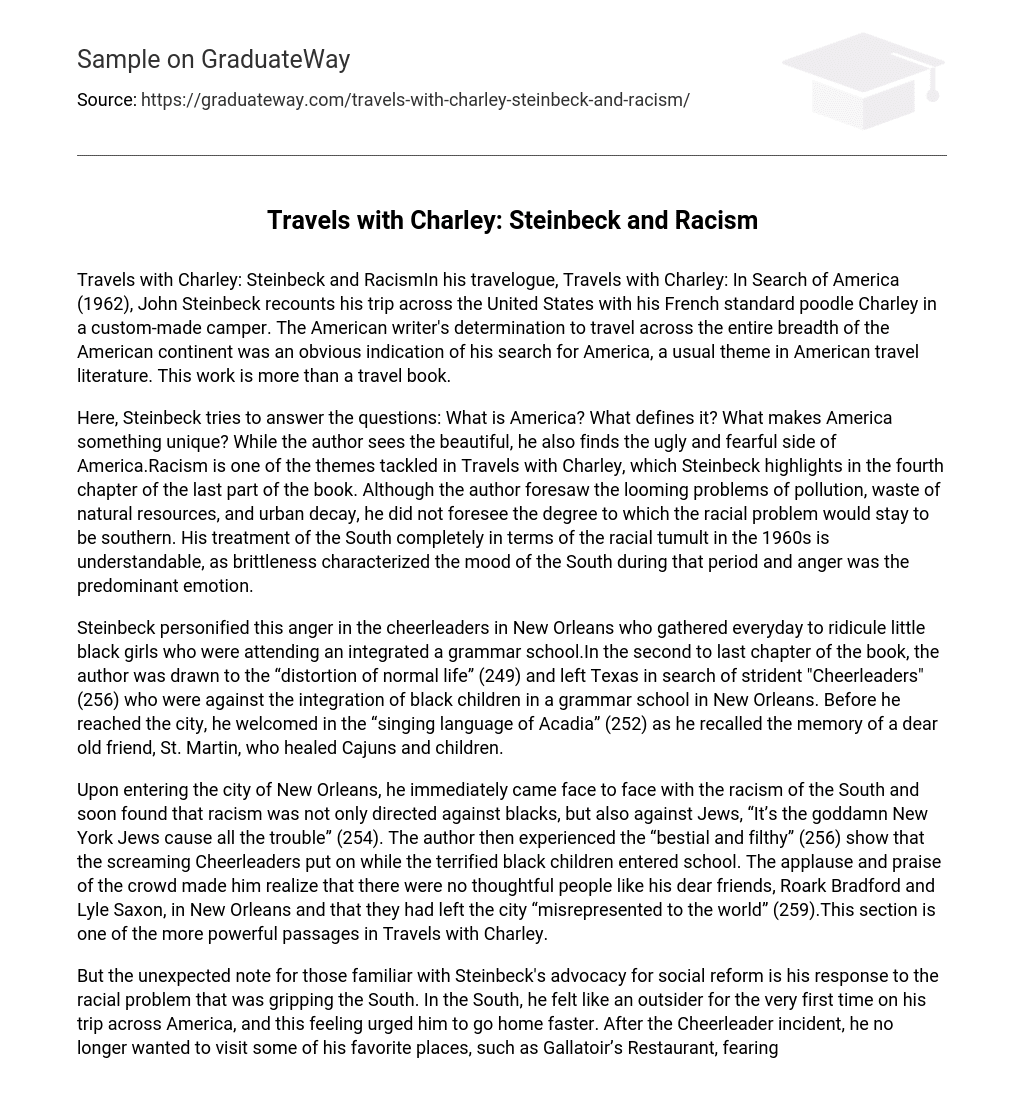In his travelogue, Travels with Charley: In Search of America (1962), John Steinbeck recounts his trip across the United States with his French standard poodle Charley in a custom-made camper. The American writer’s determination to travel across the entire breadth of the American continent was an obvious indication of his search for America, a usual theme in American travel literature. This work is more than a travel book.
Here, Steinbeck tries to answer the questions: What is America? What defines it? What makes America something unique? While the author sees the beautiful, he also finds the ugly and fearful side of America.Racism is one of the themes tackled in Travels with Charley, which Steinbeck highlights in the fourth chapter of the last part of the book. Although the author foresaw the looming problems of pollution, waste of natural resources, and urban decay, he did not foresee the degree to which the racial problem would stay to be southern. His treatment of the South completely in terms of the racial tumult in the 1960s is understandable, as brittleness characterized the mood of the South during that period and anger was the predominant emotion.
Steinbeck personified this anger in the cheerleaders in New Orleans who gathered everyday to ridicule little black girls who were attending an integrated a grammar school.In the second to last chapter of the book, the author was drawn to the “distortion of normal life” (249) and left Texas in search of strident “Cheerleaders” (256) who were against the integration of black children in a grammar school in New Orleans. Before he reached the city, he welcomed in the “singing language of Acadia” (252) as he recalled the memory of a dear old friend, St. Martin, who healed Cajuns and children.
Upon entering the city of New Orleans, he immediately came face to face with the racism of the South and soon found that racism was not only directed against blacks, but also against Jews, “It’s the goddamn New York Jews cause all the trouble” (254). The author then experienced the “bestial and filthy” (256) show that the screaming Cheerleaders put on while the terrified black children entered school. The applause and praise of the crowd made him realize that there were no thoughtful people like his dear friends, Roark Bradford and Lyle Saxon, in New Orleans and that they had left the city “misrepresented to the world” (259).This section is one of the more powerful passages in Travels with Charley.
But the unexpected note for those familiar with Steinbeck’s advocacy for social reform is his response to the racial problem that was gripping the South. In the South, he felt like an outsider for the very first time on his trip across America, and this feeling urged him to go home faster. After the Cheerleader incident, he no longer wanted to visit some of his favorite places, such as Gallatoir’s Restaurant, fearing racially divided ideals.Perhaps the author felt like an outsider in other than strictly sectional terms; Steinbeck is mistaken in his belief that racism is a problem that only people in the South can solve.
However, this may have been less hurtful compared to believing that generations of people who have not yet born would be the ones establishing racial justice. In Travels with Charley, each of his conversation with people from the South turned compulsively to the question of race. Finally, his response had a tone of exhaustion: the “dreadful uncertainty of the means” for resolving the problems really gripped him. It may be that Steinbeck’s “weary nausea” is the result of his knowing that racism in the South is a battle wherein he will not be a warrior (195–96).
After giving a ride to both a racist white man and a wary black man, Steinbeck became aware that people in the South were afraid to change their way of life and that they would accept that fear despite the improving race relations anywhere else at the time. Today, although race relations have improved significantly, covert racism still exists. Just look at how the American media portray the minority groups in the country, at the discrimination faced by immigrants in the workplace, the wage gap between the Whites and the minorities. Unlike Steinbeck’s beliefs, racism affects not only individuals or groups of people, but the American society; thus it is a problem that every American should address.
Work Cited
- Steinbeck, John, Travels with Charley: In Search of America. New York: Viking Press, 1962.





